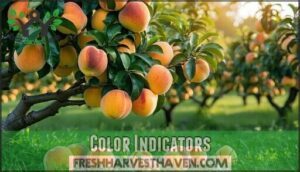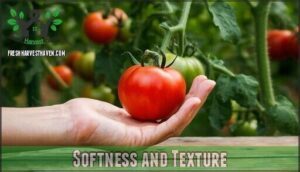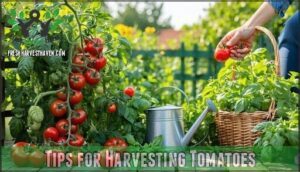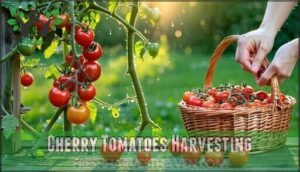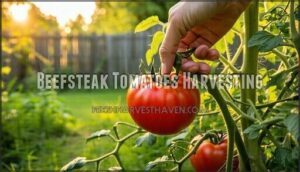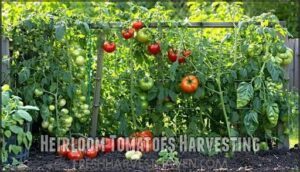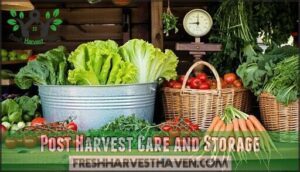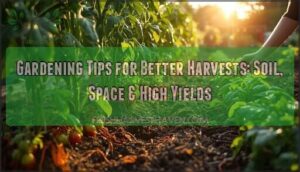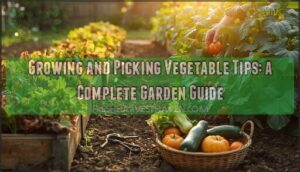This site is supported by our readers. We may earn a commission, at no cost to you, if you purchase through links.
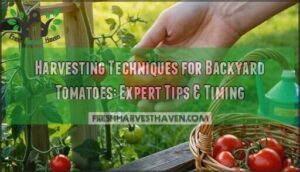 You’ll master harvesting techniques for backyard tomatoes by using the gentle twist-and-pull method with your thumb and forefinger.
You’ll master harvesting techniques for backyard tomatoes by using the gentle twist-and-pull method with your thumb and forefinger.
Pick tomatoes when they show uniform color without green shoulders, ideally between 8-10 AM for peak sweetness.
Clean hands work better than tools for small gardens, and handle fruit gently to avoid bruising.
Harvest at the breaker stage to extend shelf life, and support heavy branches while picking to protect your plants.
After harvesting, rinse tomatoes with cool water and store at 65-70°F with good air circulation, understanding that the secret lies in knowing your tomato variety’s unique ripening signals.
Table Of Contents
- Key Takeaways
- Harvesting Tomato Techniques
- Signs of Ripe Tomatoes
- Tips for Harvesting Tomatoes
- Tomato Varieties and Harvest
- Post Harvest Care and Storage
- Frequently Asked Questions (FAQs)
- What are the methods of harvesting tomatoes?
- What are the signs that a tomato is ready to be harvested?
- When should green tomatoes be harvested?
- How to ripen tomatoes off the vine?
- What causes tomato cracking during harvest season?
- Should tomato stems be removed before storage?
- How long do harvested tomatoes last?
- Can green tomatoes ripen off the vine?
- How to prevent tomato cracking during harvest?
- What causes blossom end rot in tomatoes?
- Conclusion
Key Takeaways
- Time your harvest between 8-10 AM when sugar content peaks and dew has dried – this captures tomatoes at their sweetest for maximum flavor
- Use the gentle twist-and-pull method with your thumb and forefinger to remove ripe tomatoes, avoiding tools that can bruise the fruit or damage plant branches
- Look for uniform color without green shoulders as your main ripeness indicator, and harvest at the breaker stage if you need extended shelf life
- Store harvested tomatoes at 65-70°F with good air circulation and avoid refrigeration to preserve flavor compounds and texture
Harvesting Tomato Techniques
You’ll master tomato harvesting by learning proper techniques that maximize flavor while protecting your plants. The right approach combines timing, gentle handling, and understanding when your tomatoes reach peak ripeness.
Manual Harvesting Methods
Hand-picking remains the gold standard for backyard tomato harvesting.
Use your thumb and forefinger to gently twist ripe tomatoes until they naturally separate from the stem. This technique prevents bruising while protecting the plant’s delicate branches.
Perfect timing and gentle technique create the sweetest harvest from your backyard garden.
The right harvest moment turns ordinary tomatoes into garden gold
Avoid pulling or yanking, which damages both fruit and vine. Clean hands guarantee better hygiene than tools for small harvests.
For extended shelf life, consider harvesting at the breaker stage, using techniques that follow the breaker stage for optimal results, and maintaining the delicate branches of the plant.
Mechanized Harvesting Tools
Several mechanized options can transform your backyard tomato harvesting experience. Modern Automated Tomato Pickers and AI-Powered Harvesters bring commercial efficiency to home gardens, reducing physical strain while maintaining fruit quality.
- Compact mechanical harvesters handle 1-2 tons per hour with gentle handling systems
- Robotic Harvesting Systems use vision-based guidance for selective picking of ripe fruit
- Precision Harvesting Tech features adjustable settings for different tomato varieties and plant configurations
These machine harvesting solutions offer Mechanical Stress Reduction compared to manual methods. For larger-scale operations, consider a tomato harvester designed for challenging conditions.
Timing for Optimal Flavor
Nobody wants to pick tomatoes too early and miss that perfect flavor window.
Monitor your ripening stages closely, checking daily for maturity signs like color changes and slight softness.
Create harvest schedules based on variety-specific flavor profiles.
Peak tomato ripeness occurs when fruits feel slightly yielding but remain firm.
This careful crop monitoring guarantees superior taste and texture when harvesting techniques align with natural development cycles, ensuring the best possible outcome for your tomatoes with optimal ripeness.
Signs of Ripe Tomatoes
Knowing when your tomatoes are perfectly ripe makes the difference between a mediocre harvest and bursting-with-flavor results that’ll have you bragging to the neighbors.
You’ll want to look for three key indicators that work together to signal peak ripeness: rich color changes, proper texture, and that unmistakable garden-fresh aroma.
Color Indicators
Color tells the whole story when determining tomato ripeness. You’ll spot uniform color development as tomatoes progress through distinct ripening stages, moving from green to their final hue.
Here are five key color indicators for ripe tomatoes:
- Color Uniformity – Look for consistent color across the entire fruit surface without patchy areas
- Shade Variation – Notice how colors deepen from light pink or pale yellow to rich, vibrant tones
- Green Shoulders – Check that green areas near the stem have disappeared completely
- Blush Development – Watch for the first hint of color change at the blossom end
- Ripening Stages – Identify whether tomatoes are at breaker, turning, pink, or full-ripe stage
Softness and Texture
Why squeeze when you can tell? Proper tomato firmness means gentle pressure yields slightly without mushiness factors taking over.
Ripe backyard tomatoes have skin elasticity that gives way but springs back. Internal texture should feel substantial, not hollow.
When picking tomatoes, avoid rock-hard specimens or overly soft ones. Juice content increases as ripeness peaks, making harvesting techniques vital for superior results.
Scent and Aroma
Anyone can recognize ripe tomatoes through their distinctive aroma.
The tomato fragrance intensifies as aroma compounds develop, signaling peak ripeness scent.
Different tomato varieties produce unique varietal aromas with varying scent intensity levels.
One popular choice is the Sungold cherry tomato, known for its fruity sweetness.
Notice these key indicators:
- Sweet, earthy fragrance – strongest at the stem end where aroma compounds concentrate
- Rich, complex scent – combines with ideal tomato color and perfect tomato firmness
- Immediate recognition – your nose knows when backyard tomatoes reach harvesting perfection
Tips for Harvesting Tomatoes
Perfect timing transforms your tomato harvest from good to exceptional, and proper technique protects both fruit and plant for continued production.
You’ll maximize flavor and yield by following proven methods that experienced gardeners swear by, which will help you achieve an exceptional tomato harvest.
Morning Harvest for Best Flavor
Timing your harvest right makes all the difference.
Early morning offers the sweet spot when dew effects have dried but sugar content remains high from cool overnight temperatures.
Morning harvests capture tomatoes at their sweetest, when cool nights concentrate natural sugars
Ideal time falls between 8-10 AM when flavor compounds concentrate in garden tomatoes.
Plant hydration peaks during these hours, delivering maximum tomato flavor.
Morning harvest guarantees your backyard garden produces the tastiest results through proper harvesting techniques, ensuring the best tomato flavor and overall quality by following the proper harvesting techniques.
Avoiding Damage to Plants
Gentle picking protects your garden tomatoes from unnecessary stress and disease.
Use sharp, clean pruning shears instead of yanking fruit by hand.
Support heavy branches while harvesting to prevent breaking.
Handle each tomato with care, avoiding bruising that invites rot.
Proper tool selection and careful handling techniques guarantee your tomato plants continue producing throughout the season.
For superior results, consider using specialized garden tools with sharp and clean pruning shears to ensure proper handling.
Understanding Ripening Characteristics
Tomatoes are climacteric fruits that produce ethylene, triggering distinct ripening stages you can track through visual cues.
Watch for color indicators shifting from green to red as flavor development peaks. Check texture changes—ripe tomatoes yield slightly to gentle pressure.
Understanding these ripening characteristics helps maximize your tomato yield by timing harvests perfectly according to this harvesting guide.
Tomatoes are ready to harvest once they reach their mature color.
Tomato Varieties and Harvest
Different tomato varieties require specific harvesting approaches to maximize flavor and yield. You’ll get the best results when you understand each type’s unique ripening patterns and ideal picking times.
Cherry Tomatoes Harvesting
Cherry tomatoes mature in 45-70 days, displaying variety-specific colors like ruby red or golden yellow.
You’ll know they’re ready when they separate easily with gentle twisting—no force needed.
Daily harvesting techniques prevent cracking prevention issues and maximize sweetness levels.
Check cluster harvesting spots every morning since ripe fruit attracts pests.
Store at room temperature for ideal flavor, avoiding refrigeration which impacts their natural ripening process and reduces quality, to ensure the best taste and maximize sweetness.
Beefsteak Tomatoes Harvesting
Wait for prime ripeness when beefsteak tomatoes display uniform bright color and yield slightly to gentle pressure.
These heavyweight champions need 80-100 days post-transplant to reach peak flavor.
Use proper slicing techniques by cutting with sharp knives rather than pulling from support structures.
Harvest before rain to prevent blossom-end rot and cracking.
Perfect timing guarantees superior backyard gardening results for seed saving endeavors.
Heirloom Tomatoes Harvesting
Heirloom tomato cultivation rewards you with extraordinary unique flavors that make the extra care worthwhile.
These indeterminate varieties produce continuously from midsummer until frost, requiring careful attention to variety differences and heirloom ripeness indicators.
Key harvesting techniques for success:
- Check plants every 1-2 days – Their thin skins crack easily when overripe
- Cut or gently twist fruit from vines while supporting stems to prevent plant damage
- Harvest slightly underripe before rain or frost, then finish ripening indoors on newspaper
Monitor for pest impact closely, as damaged fruit won’t store well for seed saving purposes.
Post Harvest Care and Storage
Once you’ve harvested your tomatoes, proper handling guarantees they stay fresh and flavorful for weeks.
The right storage techniques can extend your tomatoes’ shelf life while preserving their taste and nutritional value, which is a complete concept for maintaining their quality.
Handling and Cleaning Tomatoes
Handle your freshly picked tomatoes with care—they’re more delicate than they appear. Gentle handling prevents bruising and extends shelf life.
Rinse tomatoes under cool running water, removing dirt and debris. Pat dry with clean towels or air-dry completely before storage preparation.
These harvesting techniques protect your precious crop, ensuring fresh ingredients stay pristine for storing tomatoes and preserving tomatoes later.
To maintain peak flavor, remember to avoid refrigerating ripe tomatoes, and always prioritize gentle handling to prevent damage, thus preserving the peak flavor and ensuring fresh ingredients.
Storage Conditions for Freshness
Once you’ve cleaned your freshly picked tomatoes, proper storage conditions become your next priority for maintaining peak freshness and flavor.
Follow these four storage guidelines for ideal results:
- Ideal Temperature: Store ripe tomatoes at room temperature (65-70°F) to preserve flavor compounds
- Humidity Levels: Maintain moderate humidity around 85-90% to prevent shriveling without encouraging rot
- Ethylene Exposure: Keep tomatoes away from bananas and apples that release ripening gases
- Container Types: Use breathable baskets or paper bags rather than plastic for proper air circulation
Storage duration varies by ripeness—fully ripe tomatoes last 3-5 days at room temperature, while slightly underripe ones can extend to a week. This harvesting guide emphasizes that storing tomatoes properly maintains their status as fresh ingredients for your favorite recipes.
Preserving Tomatoes for Later Use
After proper storage, extending your homegrown tomatoes’ lifespan requires various preservation methods.
Freezing tomatoes works best for sauces—simply core and freeze whole.
Canning tomatoes preserves peak flavor using water bath processing.
Drying tomatoes concentrates sweetness through dehydration or oven methods.
Fermenting tomatoes creates tangy condiments.
Each technique transforms your harvest into year-round ingredients.
To find supplies for freezing ripe tomatoes, explore online retailers.
| Method | Best Tomato Type | Shelf Life |
|---|---|---|
| Freezing | Any variety | 8-12 months |
| Canning | Paste/sauce types | 18-24 months |
| Drying | Cherry/small | 6-12 months |
| Fermenting | Firm varieties | 3-6 months |
| Sauce making | Any ripe tomato | 12-18 months |
Frequently Asked Questions (FAQs)
What are the methods of harvesting tomatoes?
Picture a gardener who waits too long—green tomatoes turn mushy overnight.
You’ll harvest tomatoes using two main methods: cutting with clean shears or gently twisting ripe fruit from the vine when it’s firm yet colorful.
What are the signs that a tomato is ready to be harvested?
You’ll know your tomatoes are ready when they’re rich in color, slightly firm to touch, and easily detach from the vine with gentle pressure.
When should green tomatoes be harvested?
Roughly 25% of home gardeners lose tomatoes to early frost each year.
Harvest green tomatoes before the first frost when they’re full-sized but still firm and green, typically in late fall when nighttime temperatures drop below 50°F consistently.
How to ripen tomatoes off the vine?
Place green tomatoes in a paper bag with a banana or apple.
The ethylene gas speeds ripening.
Store at room temperature, checking daily.
They’ll ripen in 3-7 days depending on maturity.
What causes tomato cracking during harvest season?
Like a balloon that’s stretched too tight, tomatoes crack when they absorb water faster than their skin can expand.
You’ll see this happen when irregular watering causes rapid growth spurts, especially after dry spells followed by heavy rain or overwatering, leading to rapid growth spurts.
Should tomato stems be removed before storage?
Remove tomato stems before storing to prevent moisture loss and bacterial entry points. The stem end creates openings where pathogens thrive, shortening shelf life substantially.
How long do harvested tomatoes last?
Harvested tomatoes last 1-2 weeks at room temperature, or 3-4 weeks refrigerated.
You’ll get maximum shelf life by storing ripe tomatoes stem-side down in cool, dry conditions away from direct sunlight.
Can green tomatoes ripen off the vine?
Yes, you can ripen green tomatoes off the vine.
Store them at room temperature in a paper bag with a banana or apple.
The ethylene gas speeds ripening within several days to weeks.
How to prevent tomato cracking during harvest?
Maintain consistent watering to prevent beet-red splitting.
Harvest tomatoes when they’re just turning color, then let them ripen indoors.
Pick during cooler morning hours to avoid stress-induced cracking from temperature swings.
What causes blossom end rot in tomatoes?
Before you panic over those dark, sunken spots, know this isn’t a disease—it’s calcium deficiency.
Your tomatoes can’t absorb enough calcium when watering’s inconsistent, causing cell walls to collapse and creating that telltale black rot.
Conclusion
Modern harvesting techniques for backyard tomatoes require patience—something as rare as finding a rotary phone in today’s gardens.
You’ll maximize flavor by picking at proper ripeness stages and storing correctly. Remember that each variety ripens differently, so observe your plants closely.
Clean handling prevents damage while proper timing guarantees peak sweetness. Master these fundamentals, and you’ll enjoy premium homegrown tomatoes throughout the season with confidence.
- https://joegardener.com/when-is-the-best-time-to-pick-a-tomato/
- https://laidbackgardener.blog/2024/08/27/all-about-harvesting-tomatoes/
- https://www.uaex.uada.edu/counties/white/news/horticulture/tomatoes.aspx
- https://www.gardenfarmthrive.com/blog/when-to-pick-tomatoes
- https://www.gardenersedge.com/c/garden-harvest-tools

